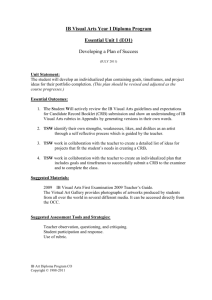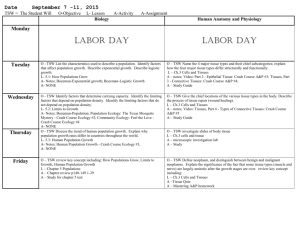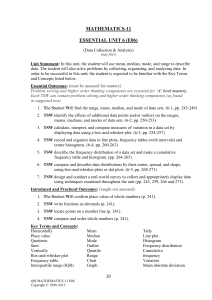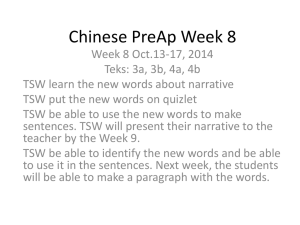MATH-11 E02
advertisement
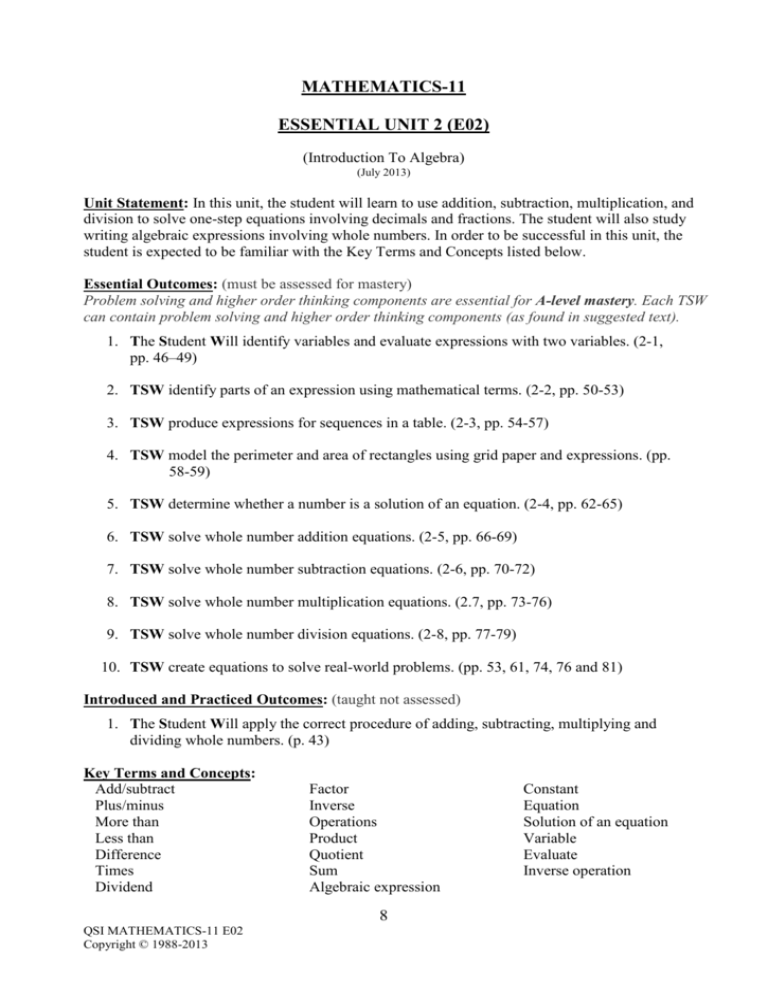
MATHEMATICS-11 ESSENTIAL UNIT 2 (E02) (Introduction To Algebra) (July 2013) Unit Statement: In this unit, the student will learn to use addition, subtraction, multiplication, and division to solve one-step equations involving decimals and fractions. The student will also study writing algebraic expressions involving whole numbers. In order to be successful in this unit, the student is expected to be familiar with the Key Terms and Concepts listed below. Essential Outcomes: (must be assessed for mastery) Problem solving and higher order thinking components are essential for A-level mastery. Each TSW can contain problem solving and higher order thinking components (as found in suggested text). 1. The Student Will identify variables and evaluate expressions with two variables. (2-1, pp. 46–49) 2. TSW identify parts of an expression using mathematical terms. (2-2, pp. 50-53) 3. TSW produce expressions for sequences in a table. (2-3, pp. 54-57) 4. TSW model the perimeter and area of rectangles using grid paper and expressions. (pp. 58-59) 5. TSW determine whether a number is a solution of an equation. (2-4, pp. 62-65) 6. TSW solve whole number addition equations. (2-5, pp. 66-69) 7. TSW solve whole number subtraction equations. (2-6, pp. 70-72) 8. TSW solve whole number multiplication equations. (2.7, pp. 73-76) 9. TSW solve whole number division equations. (2-8, pp. 77-79) 10. TSW create equations to solve real-world problems. (pp. 53, 61, 74, 76 and 81) Introduced and Practiced Outcomes: (taught not assessed) 1. The Student Will apply the correct procedure of adding, subtracting, multiplying and dividing whole numbers. (p. 43) Key Terms and Concepts: Add/subtract Plus/minus More than Less than Difference Times Dividend Factor Inverse Operations Product Quotient Sum Algebraic expression 8 QSI MATHEMATICS-11 E02 Copyright © 1988-2013 Constant Equation Solution of an equation Variable Evaluate Inverse operation Suggested Materials: Teacher’s Edition, Chapter 2, Holt McDougal, Mathematics, grade 6. Suggested Assessment Tools and Strategies: Attached rubric or teacher generated rubric that assesses ALL essential outcomes (TSWs). Assessments created by the teacher (ExamView CD-ROM) Chapter 2 tests on the ‘Teacher One Stop’ CD-ROM or in the Assessment Resources (Holt McDougal, Mathematics, Grade 6) Students keep a journal in which they write about real-life situations connected to their TSW’s (TSW 10). Students can use this same journal to rewrite explanations given as paragraphs as steps or a list (TE: p. 45). For TSW 2 they can record realworld math situations they experience at home, using both words and mathematical symbols. Students design, create, and play a game (Don’t Say the Word, Memory, Pictionary, Scrabble, Word Wall, etc.) where they can prove their understanding of the Key Terms and Concepts (TSW 1-9). Additional Resources: Sideways Arithmetic from Wayside School by Louis Sachar (see p. 45 TE) A Collection of Math, Grades 6-8 by Marilyn Burns Technology Links: Destiny WebPath Express (school library site) Lesson Tutorial Videos for every lesson (CD-ROM, Holt McDougal, Mathematics, Grade 6) Power Point Presentations for every lesson (CD-ROM; Teacher One Stop, Holt McDougal, Mathematics, Grade 6) http://my.hrw.com www.ixl.com/math (online practice for students) www.tenmarks.com (online supplemental math program) www.khanacademy.org (online practice for students) Suggested rubric found on following page…….. 9 QSI MATHEMATICS-11 E02 Copyright © 1988-2013 SUGGESTED RUBRIC MATH-11 E02 Student Name: __________________________ - Date: _______________________ To receive a ‘B’, the student must show ‘B’ level mastery on ALL Essential Outcomes (TSW’s). To receive an ‘A’, the student must show ‘A’ level mastery on all four available TSW’s and ‘B’ level mastery on all of the remaining TSW’s. ‘A’ LEVEL TSW ‘B’ LEVEL 1- TSW identify variables and evaluate expressions. 2- identify parts of an expression using mathematical terms. 3- produce expressions for sequences in a table. 4- model the perimeter and area of rectangles. The student consistently demonstrates the ability to identify variables and evaluate expressions. The student models/creates word problems independently that contains expressions and mathematical terms. The student independently creates tables and concludes an expression from that table. The student uses the correct mathematical phrases for expressions consistently. The student is able to use mental math to predict perimeter or area of a right triangle where a value has been omitted. The student uses the correct expressions to find the perimeter and area of rectangles. The student is consistent in writing expressions in a table. 5- determine whether a number is a solution of an equation. 6- solve whole number addition equations. The student applies the correct procedures in determining the solution of equations. The student consistently demonstrates the ability to correctly solve addition equations. 7- solve whole number subtraction equations. The student consistently demonstrates the ability to correctly solve subtraction equations. 8- solve whole number multiplication equations. The student consistently demonstrates the ability to correctly solve multiplication equations. 9- solve whole number division equations. The student consistently demonstrates the ability to correctly solve division equations. 10. create equations to solve real-world problems. The student provides clear explanations of his/her mathematical thinking in explaining procedures and strategies. 10 QSI MATHEMATICS-11 E02 Copyright © 1988-2013 The student consistently demonstrates the ability to apply the correct procedure or strategy in real-world problems by creating and solving equations. Notes





